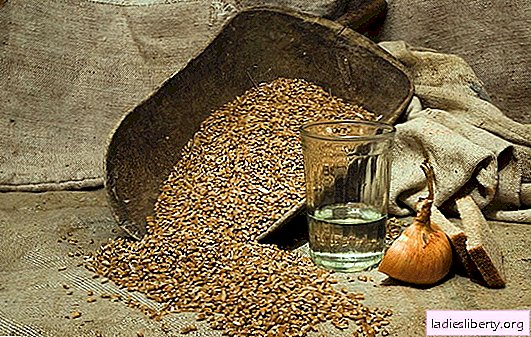
Grain distillates, but simply wheat spirit, were prepared by our ancestors in very uncomfortable conditions.
And it turned out to be far from an anecdotal "fowl."
Centuries later, will we not be able to repeat the same thing, relying on modern technology, but not neglecting traditions?
Home-made wheat moonshine: basic principles and cooking technology
The process of making moonshine usually consists of the following steps:
1. Cooking malt mash.
2. Distillation.
3. Cleaning.
4. Re-distillation.
5. Dilution of the prepared moonshine to the necessary strength.
These steps are worth considering especially at least briefly.
1. Recipes for making mash, despite the fact that we are limited to the grain option, there are dozens of species. Relatively affordable - listed below, but something needs to be negotiated in advance. Malt is germinated cereal grains; it happens to be fresh (green) and dry (light). Fresh is used immediately, and dry is usually ground into flour. Braga is prepared using yeast and yeast-free technology, which, in addition to taste, also affects the speed of fermentation. You have to choose the technique yourself, experienced distilleries go through many experiments, but rarely stop on one recipe.
2. The distillation process is no simpler, the taste of the final product depends on it to the same extent. The quality of the equipment used and strict adherence to temperature conditions are important here. Home-made, “garage” production distillation apparatuses produce a product of the same dubious quality. You can buy a good device made of suitable metal, carefully calculated for performance and equipped with the necessary accessories (filters, thermometers) using the Internet search. Usually it is equipped with operating instructions, which rarely do without mentioning the process of distilling moonshine from wheat at home.
3. If the distillation apparatus used is equipped with built-in filters, use them, although this is inappropriate if you want to get a distillate with a characteristic wheat or other grain flavor. Ideally, it is better not to use them, collect the product completely, “level” the degree to about 17% and pour activated carbon (granular) into the tank at the rate of 15 grams per liter of product. You can use charcoal for barbecue, best birch, its amount is chosen a little larger. The cleaning procedure takes about 48 hours.
4. Re-distillation is carried out in order to, as experts call it, "cut off the tails" - to get rid of the "hard" fractions of alcohol. In the process of re-distillation, the “pervak”, in an amount of about 5-8%, is collected and used as industrial alcohol. Further fractions can also be divided, but this is a complex process that requires accurate calculations; in principle, it is sufficient to periodically select a product and measure its strength. To obtain high-quality moonshine, it is advisable to stop distillation, as soon as the strength of the product goes down for 38 degrees. Residues can be re-cleaned and mixed with the next batch or used for infusion and re-distillation.
5. Dilute the finished moonshine, focusing on personal taste sensations. For the preparation of tinctures and liqueurs, they take a stronger one - 55-65 degrees, for drinking in pure form they usually use moonshine with a strength of 45 to 50 degrees. For dilution, only very pure water is used - bottled, spring, or passed through a reverse osmosis filter.
Moonshine from wheat at home from mash without yeast, on germinated grain
Ingredients:
• four kilograms of wheat;
• four kilograms of granulated sugar;
• 30 liters of purified (filtered) water.
Cooking method:
1. Pour one kilogram of washed, peeled, debris and grain husk into a metal container. Flatten it evenly over the entire bottom of the container and pour water. Water should be at least two centimeters higher than wheat. Cover the container with a lid and put it in a cool, without access to light, place on two bottoms. During this time, the grain will sprout, if this does not happen, change the grain and repeat the procedure.
2. When sprouts appear on the wheat grains, pour a pound of granulated sugar and mix the contents of the container well with your hands. If you get too thick a mass, you can add a little water. Cover the dishes with gauze and leave for a week and a half, at a temperature of 18 to 24 degrees. In such conditions, during this time a yeast is formed, which is able to replace yeast.
3. Then pour the prepared sourdough into a large glass bottle, pour three and a half kilograms of sugar, three kilograms of refined wheat and pour everything with warm, pre-boiled water, with a temperature of less than 20 degrees.
4. Take a rubber medical glove that will serve as a water seal and put it on the neck of a glass container. Lock the glove well so that it does not fly off during the fermentation process. At the same time, keep in mind that excess carbon dioxide should pass out quite freely.
5. For about ten days, put the container for fermentation in any suitable room, with indicators of thermal mode, fluctuating within 18-24 degrees, no more and no less.
6. After about ten days, the glove will deflate, which indicates that the fermentation process is completed and it is ready for distillation.
7. Drain the mash, and, pouring into the apparatus, proceed to distill the moonshine. In the residue remaining at the bottom of the dishes, you can add four kilograms of sugar, add water and reuse. You can use sediment up to three times. The best quality is the mash in the second and third use.
Home-brewed wheat from home brew on germinated grain with yeast
Ingredients:
• two and a half kilograms of quality wheat;
• twenty liters of purified, bottled water;
• six kilograms of unrefined granulated sugar;
• instant - 100 grams, or 500 grams of pressed spirit yeast;
• half a liter of fatty kefir.
Cooking method:
1. In large flat pallets with high sides, spread wheat cleaned of excess debris with a two-centimeter layer and fill it with warm water. So that the grain is guaranteed to sprout, water should be poured so that it covers the grain quite a bit. After that, remove the pallets with wheat soaked in them for several days in a dark warm place where the air temperature does not go down for 18, but does not rise above 25 degrees.
2. Usually, when the above recommendations are followed, on the third day the first shoots appear in the grains. In the absence of such, you will need to take another wheat and repeat this procedure. The absence of sprouts indicates poor grain.
3. Next, wheat should be sprouted to the point where the length of the sprouts reaches two centimeters. While wheat grains are growing, they are at least once a day very carefully turned over to prevent the process of acidification and moldiness.
4. After the sprouts have grown and started to intertwine, carefully remove them from the pallets. This is the so-called malt.
5. Pour bottled water heated to 60 degrees into a large forty-liter container, add sugar and mix to achieve complete dissolution of the crystals. When the water has cooled to 24 degrees, transfer the prepared malt and yeast diluted in the water to the container. Again, mix the contents of the container well and install a water seal on top.
6. After the mug has won back (after about 1.5 weeks), strain it through cheesecloth lined with a colander and distill into moonshine.
7. Grain, as in the previous recipe, can be used, without changing, up to 3 times.
The easiest home-made recipe for wheat at home with yeast
Ingredients:
• 21 liters of filtered or spring water;
• four kilograms of wheat grains;
• six kilograms of sugar;
• 130 grams of alcoholic pressed, necessarily fresh, yeast.
Cooking method:
1. Grind the grain, washed from foreign impurities, grind it through a meat grinder and fill it with three liters of warm, but not hot boiled water.
2. Add one kilogram of granulated sugar, one hundred grams of crushed fresh yeast, mix well until completely dissolved and cover with a lid and set aside for five days to roam in a warm place without excess light.
3. Then add the remaining water by heating it. Pour in the remaining sugar and yeast, after diluting them. Stir everything thoroughly and leave it to ferment again for another five days.
4. When the cooked mash clarifies, strain and distill it.
5. Grain is not reused with this method of preparation of mash.
A simplified version of good moonshine from wheat at home without yeast
Ingredients:
• three kilograms of durum durum wheat;
• three kilograms of sugar;
• 12 liters of purified, best bottled water.
Cooking method:
1. From three kilograms of granulated sugar and 0.6 l of water, boil the syrup and refrigerate it until it cools completely.
2. Pour the washed millet into a large enameled dish and, pouring it with the prepared chilled syrup, leave it in the open form in a warm place for four days, until carbon dioxide is released. In some cases related to grain quality, it may take longer.
3. When the surface of the syrup is covered with foam and an unpleasant sour smell appears, pour the wade into a large glass bottle.
4. Then fill in the “wade” with a slightly cooled, but still warm syrup from the remaining sugar and water.
5. Put a water trap made of a medical glove on the container and leave the mash to roam at room temperature for six days. The process can drag on for a longer time, up to one and a half weeks. It all depends on the temperature. Do not forget to periodically inspect the fermenting product, you can not allow it to sour.
6. The end of the fermentation will be indicated by the grain that has sunk to the bottom, as well as the deflated glove.
7. Upon completion of the fermentation process, you can begin the process of distillation.
Preparation of high-quality light malt for moonshine from wheat at home
Ingredients:
• water and wheat grain
Cooking method:
1. Sift full-grain wheat, stored for no more than a year, sift, rinse thoroughly with warm water and soak, preferably in a wooden container, until completely swollen. Change the water periodically, no more than every eight hours.
2. After the grain is completely swollen, spread it with a thin layer in a cool room, without access of light, covering with a thin layer of gauze. In the first five days, periodically turn the wheat over for ventilation. Then, leave it under gauze for another five days, but do not touch.
3. After ten days, the wheat will germinate, sprouts half a centimeter long will appear on it.
4. Rinse the finished malt under running water, dry it in an oven, with a temperature not exceeding 40 degrees or in fresh air until it dries completely.
5. Then grind the dried malt with a grain mill to flour. Well-dried malt before grinding, ensures its long-term storage. Store malt flour in linen bags.
"Grandmother" moonshine of wheat at home on malt
Ingredients:
• 6 kilograms of home-made wheat malt, available for purchase;
• 25 liters of distilled or purified water;
• 50 grams of dry instant (like Voronezh) or 300 grams of fresh alcoholic yeast.
Cooking method:
1. Pour the prepared malt into the selected “with a reserve”, large capacity and fill it with hot (not more than 55 degrees), boiled water. Add water in small parts, and at the same time mix the malt so that it does not stick to the bottom and lumps do not form.
2. When the mass becomes homogeneous, heat the cooked wort to 63 degrees and tightly close the lid. Insist for about an hour, keeping the temperature in the range of 57-63 degrees, while constantly stirring the contents of the container.
3. After the top of the prepared wort is clarified, and a porridge-like precipitate forms at the bottom, the must must be cooled. This must be done quickly, using forced cooling, since the time for this part of the process should take no more than 45 minutes.
4. Wort cooled down to 25-27 degrees into a container intended for fermentation, add yeast diluted in water and mix well and place under a water lock.
5. Move the vessel with the must in a dark room where the air temperature does not rise more than 25 degrees, but does not fall below eighteen.
6. The duration of fermentation depends on the sugar content of the prepared malt and the activity of the acquired yeast. Typically, the fermentation process lasts from four to seven days.
7. At least once a day, remove the water seal and stir the mash.
8. The finished mash has a slightly bitter, but generally sour taste, it is light in color.
9. Before moonshine distillation, the malt mash should be filtered through a rare sieve, otherwise small particles of the grain remaining during crushing into flour may stick to the bottom of the distillation apparatus and burn with intense heating.
Wheat moonshine at home - tricks and tips
• When choosing wheat, be sure to monitor the presence of impurities; accidentally caught seeds of other plants will ruin the taste of moonshine beyond recognition.
• Also make sure that the grains are whole, with a small amount they should even be sorted manually. "Crusher" will not sprout, but, on the contrary, will become acidic and can spoil the entire malt.
• It is preferable to take yeast alcohol, rather than baking.
• A special, "bread" flavor can be enhanced by infusing wheat moonshine at home on bread crusts. This is best done with the so-called "tails" - a product of low strength. A kilogram of bread crusts for 7-8 liters of moonshine, insist 3-7 days, according to the desired strength of the effect. You can add a few grams of ground cinnamon. Bread will suit both rye and white, white crackers should be slightly dried in the oven until slightly browned. Next, the precipitate is squeezed and discarded, and the tincture is filtered through cheesecloth, filtered and sent for further distillation.











